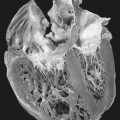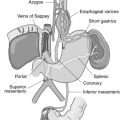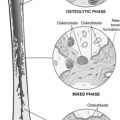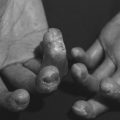43. Huntington’s Chorea
Definition
Huntington’s chorea is an incurable, autosomal dominant inherited disorder, with onset as an adult, associated with loss in specific subsets of neurons in the basal ganglia and cortex. This disorder is characterized by involuntary movements, dementia, and behavioral changes.
Incidence
The frequency of Huntington’s chorea varies significantly, depending on the particular country or region.
Etiology
The gene for Huntington’s chorea, designated IT15, is found on chromosome 4p. Selective neuronal dysfunction and loss of neurons may be explained by several mechanisms, such as excitotoxicity, oxidative stress, impaired energy metabolism, and apoptosis. One theory is that polyglutamine repeats cause neuronal degeneration through interactions with other proteins containing short polyglutamine tracts.
The duration of this disorder is quite variable, but the mean duration is about 19 years. Survival is generally 10 to 25 years after the onset of the illness.
This disorder afflicts both genders without preference. In general, onset occurs between the ages of 35 to 44 years, with a range from 2 years of age to more than 80 years. Onset of this disorder earlier than 10 years of age or later than 70 years is not unheard of, but is rare.
Signs and Symptoms
• Akinetic-rigid syndrome
• Argumentative
• Attention deficit
• Bradykinesia
• Clonus
• Dancing gait
• Dementia
• Depression
• Diminished verbal fluency
• Dramatic weight loss
• Dysarthria
• Dystonia
• Early mental status changes (increased irritability, moodiness, antisocial behavior)
• Erratic behavior
• Facial grimaces
• Fidgetiness
• Impulsive behavior
• Memory disturbances
• Obsessive-compulsive disorder
• Personality changes
• Piano-playing finger motions
• Postural instability
• Psychosis
• Rigidity rather than chorea (in children)
• Seizures
• Sexual disorders
• Sleep disorders/disturbances
• Slow cognition
• Spasticity
• Suicidal ideation/tendencies
• Uncontrollable flailing
Medical Management
Huntington’s chorea is not curable. Initial interventions are usually nonpharmacologic, directed at establishing and maintaining a safe patient environment. When the patient’s chorea advances to the point of dysfunction, administration of some form of benzodiazepine such as diazepam or clonazepam may be beneficial. Dopamine-depleting agents such as reserpine or some neuroleptic medication may prove beneficial as well.
A patient with Huntington’s chorea who has significant bradykinesia and rigidity may improve when treated with levodopa or dopamine agonists.
The depression that may accompany Huntington’s chorea must be recognized quickly and treated without delay. A selective serotonin reuptake inhibitor is the drug of choice, although bupropion, venlafaxine, nefazodone, and tricyclic antidepressants may be used effectively in some patients. Some patients with refractory depression may benefit from treatment with electroconvulsive therapy (ECT).
A patient who has hallucinations, delusions, and/or schizophrenia-like symptoms may require treatment with antipsychotic medications such as quetiapine, clozapine, olanzapine, or risperidone.
Antidepressants, selective serotonin reuptake inhibitors, mood stabilizers, and possibly atypical neuroleptic agents may be effective in treating the patient’s irritability. Mania,obsessive-compulsive disorder, sexual disorders, myoclonus, tics, dystonia, epilepsy, and anxiety are more infrequent characteristics of Huntington’s chorea that may need pharmacologic intervention.
Surgical interventions are experimental and have consisted of ablative procedures and fetal cell transplantation; however, insufficient data exist to support these interventions as anything other than experimental procedures at present.
Complications
• Choking
• Difficulty swallowing
• Increased risk for suicide due to depression
• Personality changes
• Progressive, disabling dementia
• Rigidity
Anesthesia Implications
There have been few reports of anesthesia care for patients with Huntington’s chorea. There has been a single reported case of prolonged action/delayed recovery from sodium thiopental in a patient with Huntington’s chorea; however, there have been no subsequent reports of similar responses to thiopental. The response to midazolam may also be exaggerated.
Rapid sequence or modified rapid sequence induction is recommended for the patient requiring general anesthesia. Rapid sequence induction is indicated because the patient has a greater risk of pulmonary aspiration secondary to dysphagia. For this reason, the patient with Huntington’s chorea should be assessed preoperatively to determine the degree of dysphagia that may be present. Anesthesia has been successfully induced without incident using propofol. It has also been successfully used for maintenance of anesthesia. Patients with Huntington’s chorea have a significantly higher incidence of reduced pseudocholinesterase activity. As a result, the anesthetist should anticipate a prolonged effect by succinylcholine as well as any other medications metabolized by pseudocholinesterase.
Butyrophenones and/or phenothiazines have been incorporated successfully into the anesthetic regimen to better control choreiform movements during the perioperative period. If an anticholinergic medication is required, the preferred agent is glycopyrrolate, which does not exacerbate the patient’s choreiform movements.
The degree of physiologic dysfunction present in the patient with Huntington’s chorea will determine other subsequent anesthesia concerns.
Areas of Marked Neuronal Loss in Huntington’s Chorea
• Caudate nucleus
• Cerebellum
• Deep layers of the cerebral cortex
• Globus pallidus
• Neostriatum
• Putamen
• Substantia nigra
• Subthalamic nucleus
• Thalamus
Huntington’s Chorea Severity Grading
Grade 0: No detectable histologic neuropathology in the presence of a typical clinical picture and positive Huntington’s chorea family history
Grade 1: Neuropathologic changes detected microscopically but without gross atrophy
Grade 2: Striatal atrophy present but caudate nucleus is still convex
Grade 3: More severe striatal atrophy, flat caudate nucleus
Grade 4: Most severe striatal atrophy, caudate nucleus medial surface is concave







